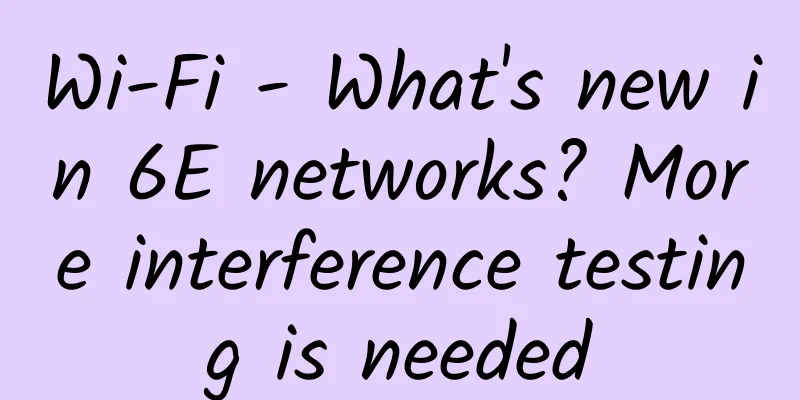Wi-Fi - What's new in 6E networks? More interference testing is needed

|
Just like cellular standards, Wi-Fi standards are constantly evolving. Wi-Fi 6E is the latest in a long line of wireless standards. The standard enables wireless Internet of Things (IoT) devices to operate in the unlicensed 6 GHz spectrum to access more bandwidth. But there’s a tricky part: The 6 GHz spectrum brings new restrictions to device manufacturers. Why? Because many devices are already using the 6 GHz band. Therefore, Wi-Fi 6E requires new testing to prevent interference. First, let’s quickly review Wi-Fi standards to position Wi-Fi 6E within the standards evolution. Wi-Fi is not a new technology. The first Wi-Fi standard appeared in 1997. Over the years, link rates have increased from 1 to 2 Mbps to 600 to 9,608 Mbps, but mostly using the same frequency bands. Wi-Fi 6E is the first in the standard’s history to use new spectrum. Wi-Fi 6E is an extension of Wi-Fi 6, also known as 802.11ax. Wi-Fi 6 uses Orthogonal Frequency Division Multiple Access (OFDMA) technology to improve network performance and higher-order Quadrature Amplitude Modulation (QAM) formats to increase data rates. Wi-Fi 6 devices operate in the 2.4 and 5 GHz bands, while Wi-Fi 6E operates in the unlicensed 6 GHz spectrum. The 6 GHz band has more available bandwidth. For example, these devices can access 1,200 MHz of contiguous bandwidth in the United States and areas that comply with Federal Communications Commission (FCC) regulations, and 480 to 500 MHz in Europe and areas that comply with European Telecommunications Standards Institute (ETSI) standards based on regulations from the Radio Equipment Directive (RED). Preventing InterferenceThe additional bandwidth available in the 6 GHz band offers great potential for device manufacturers to deliver higher performance and new applications to end users. Wi-Fi 6E brings consumers faster, more reliable Internet access for video streaming, online gaming, and video calling. The standard also helps businesses accelerate digital transformation. First, IT departments can allow more devices to access their networks and improve the user experience, thereby increasing productivity and innovation. High-density environments such as airports, stadiums, convention centers, and educational and medical facilities can also benefit greatly from Wi-Fi 6E because it enables them to handle a greater number and variety of devices. However, utilizing the additional bandwidth available in the 6 GHz spectrum is not without its challenges. A major issue is that many users are already using the spectrum, including 5G cellular, Wi-Fi access points, satellite links, mobile TV broadcasts, and utility communications links. In addition, incumbent operators are given priority over other users. As a result, the FCC and ETSI are requiring several new tests to ensure efficient use of the spectrum. The new tests considered necessary to prevent interference in Wi-Fi 6E setups are outlined below. 1. Contention-Based Protocol (CBP) TestCBP testing is an important new program mandated by the FCC. It is named after the use of CBP in devices to prevent interference with existing carriers' services. The FCC requires all device categories (access points and clients) to undergo and pass this test. Figure 1 shows the CBP test setup. The setup consists of two signal analyzers and an additive white Gaussian noise (AWGN) signal source that generates 10 MHz wide noise (existing signal) for the test signal. This test also requires the client device to communicate with the device under test (not shown) and signal conditioning components. For a 20 MHz channel, the signal source needs to inject the existing signal at one frequency within the channel, while for a 160 MHz channel, the signal source needs to inject the existing signal at three different frequencies within the channel. Figure 1 This diagram shows the conducted CBP test setup. Source: KDB 987594 D02 V01r01 2. Adaptability/Channel Access Mechanism (CAM) TestThe Adaptability/CAM test is the ETSI equivalent of the FCC CBP test, albeit much more complex. It focuses on the automatic mechanism by which a Listen Before Talk (LBT) device checks the channel before transmitting data. The standard also requires the device to check the probability of other devices using the channel to ensure fair use of available channels. CAM testing is complex and time consuming because it requires extensive data processing to calculate the results. Quantifying the probability that another device is using the channel of interest requires dividing the minimum idle time by the maximum channel occupied time (COT), which varies by device class. COT measurements can require a large number of samples. For example, a load-based device (LBE) may require more than 10,000 samples with a resolution of 1 microsecond or less, which results in measuring and collecting many data points. Adaptability testing also includes performing interference analysis by injecting various signals into the device to evaluate its ability to detect and respond to those signals. This test requires a 5G New Radio (NR) waveform to simulate interference from 5G users. You also need a known signal level and bandwidth and apply the results of the previously performed Occupied Channel Bandwidth (OCB) test. 3. Receiver selectivity testFormerly known as the receiver adjacent channel selectivity test, receiver selectivity is another new interference-related test from ETSI. It consists of measuring the ability of a device to receive a wanted signal on its channel without being degraded beyond a certain level by the presence of interfering signals in adjacent channels. The test consists of three main steps. The first step is to determine the minimum power value (P min ) of the device signal at which the packet error rate (PER) is slightly less than 10%. The next step is to add interference in the upper channels (above 20 and 40 MHz) and check whether the device's PER is less than or equal to 10%. The last step involves adding interference in the lower channels (below 20 and 40 MHz) and checking the PER again. Figure 2 shows the setup for receiver selectivity testing. It includes passive components and may require a shielded room or Faraday cage. A variable attenuator and a packet measurement system are also required to find the Pmin value and determine the PER. Using signal conditioning components and a packet counter makes the test more manageable with just a few front panel connections. Figure 2 The receiver selectivity test setup above uses the X8749A signal conditioning test set and a packet counter. Source: Keysight Technologies 4. Dual client testThe dual client test is another new test, but one from the FCC. Since client devices can connect to standard power access points, low power indoor access points, or both, the FCC requires this test to verify that client devices can flexibly connect to both types of access points, switching seamlessly between the two. The dual client test verifies that these client devices can distinguish between the different access point configurations and control the power levels of each. A connected dual-client test setup is shown in Figure 3. This test will require Gold-level low-power and standard-power access points, variable attenuators, and signal conditioning components. Figure 3 Dual-client connection testing verifies that the client device can distinguish between different access point configurations. Source: Keysight Technologies Solving interference issues in Wi-Fi 6E devicesWi-Fi 6E is an exciting new addition to the Wi-Fi standards landscape. The massive amount of extra bandwidth at manufacturers’ fingertips enables higher performance and new applications for end users (consumers and businesses). The standard also brings new challenges, primarily because it uses the 6 GHz spectrum. The 6 GHz band is already in use by many other devices, including incumbent carriers that prioritize other users. Therefore, new testing is needed to prevent interference. For more information on these tests, measurement examples, and to understand other new test requirements for Wi-Fi 6E devices, watch the webinar “Understanding Regulatory Testing for Wi-Fi 6E Devices.” |
<<: 2022 Network Open Source Technology Ecosystem Summit (Online) concluded successfully
Recommend
10 questions to ask during TCP protocol interview
First show the mind map of this article TCP, as a...
It is estimated that 5G will directly drive economic output of 1.45 trillion yuan in 2022
On January 8, 2023, China Academy of Information ...
6 hot trends in IT recruiting, and 5 that are cooling down
A global pandemic, the resulting recession and na...
Will 5G really kill Wi-Fi? NR-U is here
5G is like an elephant running wildly in the wire...
Network slicing will become the ideal architecture for 5G, but commercial deployment still faces multiple challenges
The 5G era is coming, and applications based on m...
A collection of network failure and cause analysis (with solutions included)
[[265984]] In life and work, we will inevitably e...
spinservers New Year promotion: 10Gbps San Jose/Dallas high-end servers starting from $89/month, instant activation and support for Alipay/WeChat
spinservers has released a promotional coupon cod...
Vietnam's three major operators reach 5G RAN equipment sharing agreement
[[404902]] Vietnam’s three largest operators, Vie...
Ethernet welcomes new growth: Experts' view on automotive Ethernet and AVB technology
Before discussing automotive Ethernet, let’s take...
What is the difference between unmanaged and managed industrial network switches?
There are two basic types of industrial network s...
How the global 5G network will reshape future defense strategies
Explore the impact of global 5G networks on futur...
What Software-Defined LAN Means for Campus Virtualization
Software-defined LAN, or SD-LAN, is the applicati...
Graphical explanation | A brief history of what is HTTP
[[344212]] This article is reprinted from the WeC...
Huawei Vice Chairman Hu Houkun: Crossing the business chasm and creating new 5G value
During the 2020 Global Mobile Broadband Forum, Hu...
September operating data of the three major operators: 5G enters the harvest period after entering the "warming up" mode
Unconsciously, the third quarter of 2020 has come...









